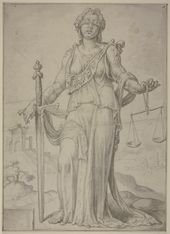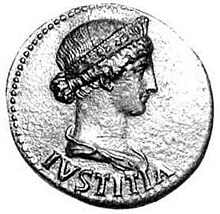Lady Justice
Justitia is the goddess of justice . While it stands for equalizing justice in ancient Roman mythology and is therefore closely related to the aequitas in representation and nature , it has been mixed up with the Greek mythical prosopopoies Dike and Themis since the Augustan period within the framework of the Interpretatio Romana . With the Greeks, Themis embodies the justice existing through traditional, divine order, while Dike, on the other hand, embodies the punitive, avenging justice. This latter attribution has an impact in the Christian Middle Ages and modern times, where Justitia in art and literature stands for punitive justice or the legal system .
Lady Justice in Roman mythology
In Roman mythology it only plays a role in one place, and that is in the myth of the ages . Here Lady Justice, identified with Astraea , as the last of the heavenly ones , leaves the crime-filled earth of the Iron Age and returns to her unearthly home or is transferred to heaven as the constellation of the Virgin . It has a direct equivalent in the Greek term dikaiosyne ; iustitia is counted among the cardinal virtues by some ancients .
iconography
In antiquity, their representation corresponds to that of the aequitas, i.e. H. its attributes are the scales , with the help of which each is measured, and the cornucopia that donates the wealth to be distributed. The formula " To each his own " ( suum cuique tribuere ) goes back to Plato's Politeia , who took it over from the poet Simonides von Keos . Cicero coined the term so decisively that it was to become decisive in the legal philosophy of the West. Such depictions of Justitia / Aequitas appear frequently on coins from the imperial era, where, as part of political propaganda, they symbolize the emperor in his role as a donor of material security, who prefers no one (which is why the balance beam is always shown in a horizontal position). Even Augustus ascribed himself in his deed report Res Gestae iustitia as one of four ruler's virtues - next to virtus (“manliness”), clementia “mildness” and pietas (“piety”).
Like other deities, she is often shown with a diadem , as can be seen on a coin of Nero on which Agrippina the younger is depicted as Justice .
Iconography of Justitia in the Middle Ages and in Modern Times


In the Middle Ages and in modern times is the image of Justitia a completely different than in Roman times: Now Justice is usually as Virgin shown that in the left hand a scale , in his right hand the sword of justice holds. Since the end of the 15th century, Justitia has been shown blind or one-eyed, later even more clearly with a blindfold. In the legal books of the late medieval town clerks of Eisenach , Johannes Rothe and Johannes Purgold , the one-eyedness of Justitia is explained for the first time in German: it is a symbol of impartiality, i.e. judging without regard to the person. Images of the eye-less and partly hands-free Justitia can be found since 1420 in the previously unedited Codex Casanatensis , which was created in Silesia or Bohemia . The blindfold has only become a standing attribute since the beginning of the 16th century . The Fountain of Justice in Bern is a prominent example from this period .
The three attributes of blindfold, scales and swords are intended to make it clear that the law is spoken without regard to the person (blindfold), after careful consideration of the facts (scales) and finally enforced with the necessary rigor (sword).
The scales of modern Justitia are the judge's scales, with whose help the pros and cons are weighed against each other, and whose role ultimately corresponds to the role of the scales in the Egyptian judgment of the dead . In accordance with the criminal law principle of In dubio pro reo ("in case of doubt for the accused"), and because the opposing interests are balanced in civil proceedings, the balance bar - unlike in Roman representations - is often inclined. In older depictions, the goddess of legal peace wears an olive branch instead of a sword . This symbolizes the peace that is to be achieved through the balance between disputed civil law interests - symbolized by the inclined balance beam.
heraldry
see balance (symbol)
literature
- Maria Caccamo Caltabiano: Justice . In: Lexicon Iconographicum Mythologiae Classicae (LIMC). Volume VIII, Zurich / Munich 1997, pp. 661-663.
- Barbara Degen: Justitia is a woman. History and symbolism of justice, catalog for the exhibition "Cornucopia, scales, sword - Justitia is a woman" / House of Women's History, 2008.
- Stefan Hess : rulers' ideals and ideal women. Virtue allegories in early modern Basel, in: Basler Zeitschrift für Geschichte und Altertumskunde 111 (2011), pp. 115–154 ( digitized version ).
- Elisabeth Holzleithner : Justice , Vienna 2009.
- Otto Rudolf Kissel : The Justitia. Reflections on a symbol and its representation in the fine arts, Munich 1984.
- Kurt Latte : Justice. In: Paulys Realencyclopadie der classischen Antiquity Science (RE). Volume X, 2, Stuttgart 1919, column 1339.
- Lars Ostwaldt: Aequitas and Justitia. Your iconography in antiquity and early modern times. Junkermann, Halle (Saale) 2009, ISBN 978-3-941226-05-0
- Heinrich Wilhelm Stoll : Justice . In: Wilhelm Heinrich Roscher (Hrsg.): Detailed lexicon of Greek and Roman mythology . Volume 2.1, Leipzig 1894, column 762 ( digitized version ).
- Wolfgang Pleistern / Wolfgang Schild (eds.): Law and Justice in the Mirror of European Art , Cologne 1988.
- Christian-Nils Robert: La Justice. Vertu, courtisane et bourreau, Geneva 1993.
- Wolfgang Schild: Pictures of Law and Justice , Cologne 1995.
- Lambert E. van Holk: Justitia, image and symbol in the 17th century in the Netherlands, in: Research on legal archeology and legal folklore, Vol. 3, Zurich 1981, pp. 155–199.
- Sven Behrisch: Justitia. An Approach to the Allegory of Justice , Weimar 2006
Web links
- Literature about Justitia in the catalog of the German National Library
Individual evidence
- ↑ Ovid Fasti 1, 249; Metamorphoses 1, 150. Virgil Georgica 2, 474.
- ^ Hyginus Mythographus , Fabulae 130; De astronomia 2, 25.
- ↑ Cicero De inventione 2, 53, 160; De re publica 3, 11, 18; De legibus 1, 6, 19; De officiis 1, 5, 15.Ulpian Digest 1, 1, 10.
- ↑ Ostwaldt: Aequitas and Justice. 2009, p. 27 and passim.

